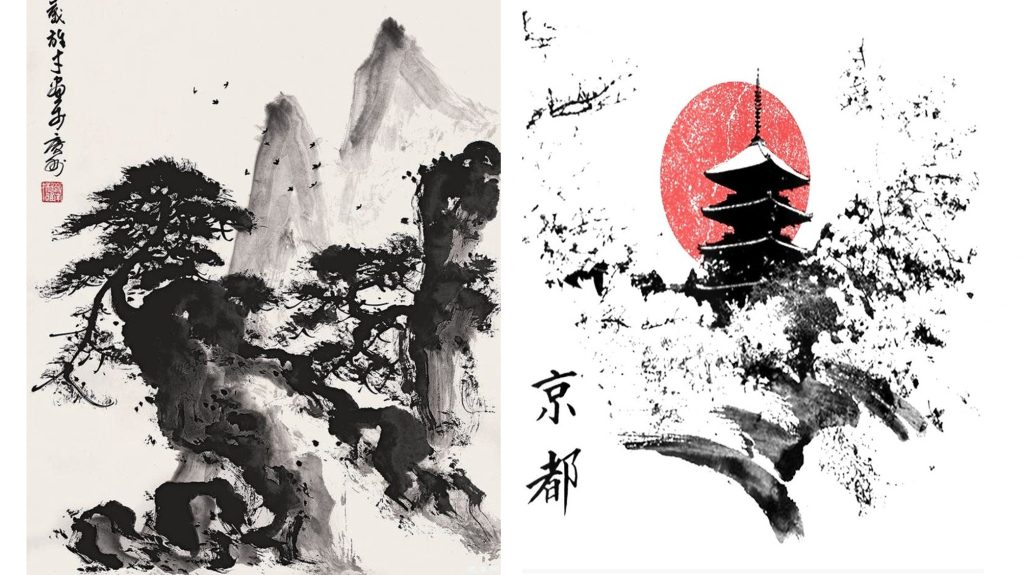Introduction
Chinese drawings, with their intricate styles and rich histories, represent a profound aspect of Chinese culture and artistry. From ancient scrolls depicting landscapes to contemporary interpretations that challenge traditional norms, Chinese drawings encompass a wide array of subjects and techniques. At China Art Hub, we celebrate this vibrant art form by offering a curated selection of authentic Chinese drawings. This blog will explore the history, techniques, and significance of Chinese drawings, as well as tips for appreciating and collecting these exquisite pieces.
A Historical Overview of Chinese Drawings
Origins and Early Forms
The roots of Chinese drawing can be traced back thousands of years, evolving alongside the development of Chinese painting and calligraphy. Early drawings often served practical purposes, such as documenting events, rituals, and daily life.
- Neolithic Period (c. 10000–2000 BCE): Some of the earliest forms of Chinese art included pottery and rudimentary drawings on ceramics, often depicting animals and human figures.
- Shang Dynasty (c. 1600–1046 BCE): Oracle bone inscriptions mark a significant advancement in early Chinese writing and drawing, as they were used for divination purposes.
The Flourishing of Drawing in the Tang and Song Dynasties
During the Tang (618–907 CE) and Song (960–1279 CE) Dynasties, drawing evolved into a sophisticated art form that incorporated various techniques and styles.
- Tang Dynasty: This period is noted for its vibrant art scene, with drawings often depicting court life, landscapes, and religious themes. Artists began to experiment with perspective and composition.
- Song Dynasty: Known for its emphasis on nature and landscapes, Song drawings often showcased delicate brushwork and attention to detail. The famous landscape painter Fan Kuan exemplified this trend with his monumental works.
Ming and Qing Dynasties
The Ming (1368–1644) and Qing (1644–1912) Dynasties saw further developments in Chinese drawing, characterized by distinct styles and techniques.
- Ming Dynasty: Artists like Shen Zhou and Dong Qichang emphasized individual expression and personal style, leading to a flourishing of literati painting that influenced drawing practices.
- Qing Dynasty: The Qing era saw a blend of traditional and Western influences, with artists experimenting with new techniques and subjects, including portraiture and still life.
Techniques and Styles of Chinese Drawings
Chinese drawing techniques are diverse, with various styles reflecting the artist’s intention and cultural context. Here are some key techniques and styles:
1. Traditional Brushwork
Traditional Chinese drawings often utilize specific brush techniques that create distinctive line qualities. These include:
- Fine Lines: Delicate strokes used for intricate details, often seen in floral and animal drawings.
- Bold Strokes: Strong, sweeping lines that convey movement and energy, commonly used in landscape and figure drawings.
2. Ink Wash Painting (水墨画, shuǐmòhuà)
Ink wash painting is a unique technique that combines drawing and painting, using varying shades of ink to create depth and texture. This method often emphasizes spontaneity and expression, allowing artists to convey emotions through fluid brushwork.
3. Gongbi (工笔)
Gongbi, or meticulous brushwork, is a detailed and realistic style of drawing that requires precision and patience. This technique is often used for portraits and floral compositions, showcasing the artist’s skill and attention to detail.
4. Xieyi (写意)
Xieyi, or freehand style, emphasizes expressive brush strokes and spontaneity. This approach allows artists to capture the essence of a subject without focusing on minute details. Xieyi is often used in landscape and figure drawings.

The Themes of Chinese Drawings
Chinese drawings often reflect cultural values, philosophical ideas, and the natural world. Here are some prominent themes found in this art form:
1. Nature and Landscapes
Nature has always been a significant source of inspiration for Chinese artists. Drawings of mountains, rivers, and flora capture the beauty of the natural world and often convey philosophical ideas about harmony and balance.
2. Animals
Animal symbolism is prevalent in Chinese art, with various creatures representing different virtues and qualities. For example:
- Dragons symbolize power and strength.
- Crane represents longevity and good fortune.
- Tigers embody bravery and courage.
3. Human Figures
Drawings of human figures often depict daily life, historical events, and mythological narratives. These drawings can range from realistic portrayals to stylized representations, reflecting the artist’s interpretation.
4. Calligraphy and Poetry
Many Chinese drawings incorporate calligraphy and poetry, intertwining visual and literary arts. This combination enhances the meaning of the artwork and connects it to Chinese literary traditions.
The Significance of Chinese Drawings
Chinese drawings hold profound cultural and artistic significance:
1. Cultural Heritage
Chinese drawing is a vital expression of cultural identity and heritage. It reflects the values, beliefs, and aesthetics of Chinese society throughout history.
2. Artistic Expression
Drawing serves as a medium for artists to express their emotions, ideas, and perspectives. Each piece becomes a unique testament to the artist’s creativity and skill.
3. Educational Value
Traditional drawing techniques and styles are often taught in art schools, preserving the knowledge and practice of this ancient art form. Learning these techniques fosters a deeper appreciation for the craft.
How to Appreciate Chinese Drawings
To truly appreciate Chinese drawings, consider the following tips:
1. Understand the Techniques
Familiarize yourself with the various techniques and styles used in Chinese drawing. Understanding the methods enhances your appreciation of the artistry involved.
2. Explore the Themes
Pay attention to the themes present in the drawings. Understanding the symbolism and cultural context can deepen your connection to the artwork.
3. Attend Exhibitions
Visit art galleries and exhibitions showcasing Chinese drawings. Engaging with the artwork in person allows for a more immersive experience.
4. Connect with Artists
Engage with contemporary Chinese artists through workshops or online platforms. Learning from their experiences and insights can enrich your understanding of the art form.
Collecting Chinese Drawings
If you are interested in starting a collection of Chinese drawings, here are some tips to guide you:
1. Research Artists
Familiarize yourself with notable Chinese artists and their styles. Understanding their contributions can enhance your appreciation of their works.
2. Set a Budget
Determine how much you are willing to spend on your collection. Prices for Chinese drawings can vary widely, so having a budget helps narrow down your options.
3. Verify Authenticity
Ensure that you are purchasing authentic pieces. Look for reputable sources, such as China Art Hub, which offers a curated selection of genuine Chinese drawings.
4. Consider Display Options
Think about how you want to display your drawings. Framing, mounting on scrolls, or using stands can enhance the presentation of your artwork.
5. Join Collectors’ Communities
Connect with other collectors to share experiences, knowledge, and insights. Engaging with a community can provide valuable resources and support for your collecting journey.
Chinese Drawings in Contemporary Art
Chinese drawings continue to evolve in contemporary art. Modern artists often blend traditional techniques with innovative concepts, creating unique pieces that resonate with a global audience.
Embracing Innovation
Contemporary artists are exploring new materials, mixed media, and digital techniques, pushing the boundaries of traditional drawing. This experimentation allows for fresh interpretations of classic themes and styles, making Chinese drawing relevant in today’s art scene.
Global Recognition
Chinese drawings are gaining recognition worldwide, with exhibitions showcasing the works of contemporary artists. This increasing visibility helps foster a greater appreciation for Chinese artistic traditions and their modern expressions.
Conclusion
The art of Chinese drawings is a captivating blend of history, technique, and cultural significance. From ancient scrolls to contemporary masterpieces, Chinese drawings reflect the beauty and depth of Chinese heritage. At China Art Hub, we are dedicated to preserving and promoting this incredible tradition by offering a diverse selection of authentic drawings.
Whether you are an avid collector or simply an admirer of art, exploring the world of Chinese drawings can enrich your understanding and appreciation of this timeless craft. Discover our collection today and bring a piece of Chinese artistic heritage into your life.

